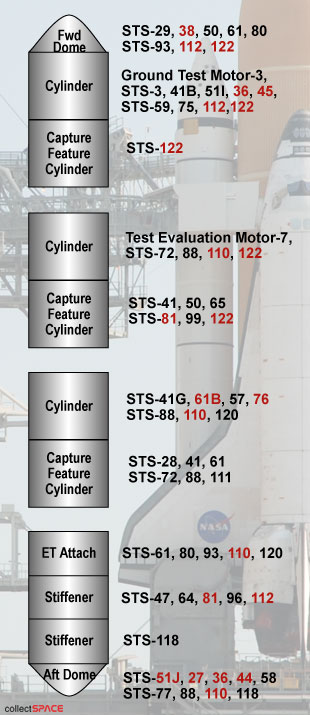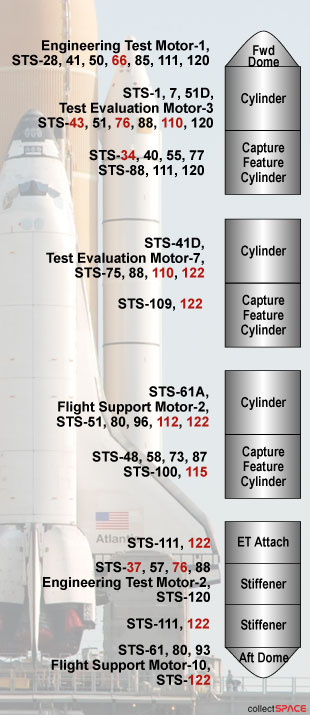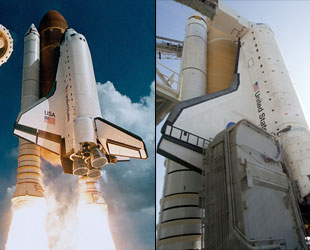May 10, 2010 — When space shuttle Atlantis lifts off later this week on what NASA has planned to be its final flight, helping to launch it will be a rocket booster segment that first flew 25 years ago on the orbiter's maiden mission.
The aft dome on the left solid rocket booster scheduled to loft Atlantis' STS-132 mission to the International Space Station (ISS) Friday, May 14, first launched STS-51J, the orbiter's first flight to space, on Oct. 3, 1985.
The almost quarter-century reunion between Atlantis and its reusable solid rocket booster's casing is just one of the historical connections between the orbiter and its launch system. Including STS-132, 18 of Atlantis' 32 flights are represented by the boosters' segments, underscoring the legacy that NASA's fourth-to-fly orbiter will leave after it is retired.
Not that Alliant Techsystems, or ATK, NASA's contractor for the shuttle's solid rocket boosters, had history in mind when it selected components from its inventory to launch Atlantis on its final flight.
"It was a coincidence," wrote Harry Reed, ATK's program director for the reusable solid rocket motors (RSRM), in an e-mail to collectSPACE.com, referring to the first and last mission pairing. "The metal case segments are assigned based on hardware availability and fit considerations with mating segments."
Even knowing it was a coincidence, the presence of the earlier missions' hardware elicited further reflection on the shuttle's history by those who have and will fly aboard the orbiter to space.
"I'm glad that [the rocket boosters' history] was dug up," said STS-132's pilot Tony Antonelli. "I think there are still a lot of people who don't understand we reuse those solid rocket motors."
"It adds to the richness of the thoughts that I'll have when I watch Atlantis launch this time, to know that there's a lot more of my heritage there than I expected," said Jerry Ross, chief of NASA's Vehicle Integration Test Office and the astronaut who has flown the most on Atlantis. Out of his seven total flights, a record unto itself, Ross flew five times aboard Atlantis.
Case history
For Atlantis' final commander, the prior missions provide context for his and his five crewmates' STS-132 flight.
"I guess I would have to say its relatively unremarkable," said Ken Ham, reflecting on Atlantis' final mission. "From looking at the list of all the incredible things that Atlantis has done, let alone the other shuttles, this is [just] another mission to Space Station."
"From a personal perspective, it's remarkable -- but when you look at [Atlantis' history], it is probably not. Carrying a Russian-built module is a first and that is interesting," he said, referring to STS-132's primary payload, the Russian Mini Research Module-1 (MRM-1) "Rassvet."
Space shuttle Atlantis' spaceflight career began on Oct. 3, 1985, with the launch of STS-51J, a classified mission dedicated to the Department of Defense. It was the fourth orbiter manufactured following Columbia, Challenger, and Discovery, and only Endeavour followed it.
Construction of Atlantis, referenced by NASA internally by its airframe number OV-104, began in March 1980 at the Palmdale, Calif., manufacturing plant. It arrived at NASA's Kennedy Space Center in Fla., in April 1985 ahead of its maiden mission.
Named after the primary research vessel for the Woods Hole Oceanographic Institute in Massachusetts from 1930 to 1966, space shuttle Atlantis has carried on the spirit of the sailing vessel with voyages to the Russian station Mir and deployment of the Galileo probe to Jupiter in 1989 and the Compton Gamma Ray Observatory in 1991.
Out of Atlantis' 31 missions to date, 17 are represented by its last set of solid rocket motor segments' earlier flights.

| Flight history for STS-132's left solid rocket booster. Mission numbers in red indicate Atlantis' flights. (collectSPACE/ATK) |
In addition to its first and second missions, STS-51J and -61B -- the latter's flown case found just above the earlier on the left booster -- Atlantis' third flight, which was the second to launch after the loss of Challenger in 1986, is also represented by the same aft dome segment that flew with the maiden mission 51J. Like that first flight, STS-27 was a classified mission for the Department fo Defense.
Atlantis went on to carry three more military payloads on missions STS-36, -38 and -44, all of which launched with segments from STS-132's boosters.
Atlantis' aforementioned flights to deploy Galileo (STS-34) and the Compton Gamma Ray Observatory (STS-37) also find parts from their boosters flying with OV-104's ultimate mission. NASA's fourth orbiter launched one other probe, Magellan to Venus on STS-30, but that's not included with STS-132's solid rocket casings.
The top cylinder on the right booster lifting off Friday once flew with Atlantis to orbit TDRS-E, the fifth tracking and data relay satellite used by the orbiters and space station to relay communications to the ground.
The same rocket casing later lifted off to support the third flight dedicated to ATLAS, the Atmospheric Laboratory for Applications and Science, on STS-66 in 1994. The cargo bay-mounted Spacelab pallet flew its first flight on Atlantis as well, as represented by the same position case on the right booster.

| Flight history for STS-132's right solid rocket booster. Mission numbers in red indicate Atlantis' flights. (collectSPACE/ATK) |
All but one of Atlantis' other flights visited space stations. OV-104 docked seven times with the Russian Mir station, an international collaboration that led into the assembly of the International Space Station (ISS). Including STS-132, Atlantis will have visited the ISS 11 times.
Atlantis' final set of solid rocket boosters also capture this history by including two segments that boosted the orbiter to Mir and four that earlier launched Atlantis on ISS-bound missions.
Among the latter, at the very top of the left-side rocket, is a segment that flew with STS-132 mission specialist Piers Sellers on STS-112, his first flight on Atlantis in 2002.
The only type of Atlantis' 32 flights not represented by the two 150-foot boosters to either side of it on the launch pad is its servicing
mission to the Hubble Telescope one year ago this month. That flight, STS-125, did however include astronaut Michael Good, who is now set to fly on Atlantis' final mission.
Lasting legacy
Atlantis is the first of NASA's remaining three shuttles to reach its
final planned flight.
After the STS-132 mission is over, Atlantis will once again be readied to launch but will only fly should an emergency arise on the
very last shuttle mission, STS-134, set to fly on shuttle Endeavour no earlier than November. As such, Atlantis is expected to experience spaceflight for the last time this month.
Atlantis' missions account for about a quarter of the space shuttles 134 missions in total. STS-132's boosters reflect that larger legacy, too.
In addition to the segments having flown on 17 of Atlantis' prior missions, there are also components that flew on 40 other shuttle missions, representing the other four shuttle orbiters.
There is even a segment that lifted off with the very first shuttle mission. The very same top right cylinder that flew with Atlantis to orbit TDRS-E and later loft ATLAS-3, first launched STS-1 in April 1981.



